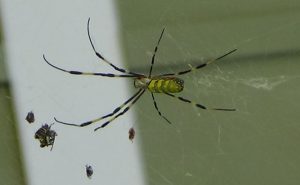
By Beverly Adams, ANR Program Assistant, UGA Extension Forsyth County
We fielded a lot of questions about Joro spiders, which were present in noticeably large numbers this fall. Here’s the skinny on this large, relatively new spider.
The Joro spider belongs to a group of large spiders known as golden orb-web weavers. Females weave enormous, multi-layered webs of gold-colored silk. Species in this group are found throughout the tropical and subtropical regions of the world, including one—the banana spider—that is native to the southeastern U.S. The Joro spider is originally from Asia. They are found throughout Japan, in Korea, Taiwan, China, and now, North Georgia. They were first noted in Georgia in 2013 and 2014. Entomologists believe they arrived here in shipping containers destined for the Interstate 85 distribution centers.
Female Joro spiders are boldly patterned in black, yellow, and red. They are four times larger than the male and can have a leg span of 3-4 inches. Males are mostly a dull brown. The females reach maturity in early September and die off with the cold weather by late November – but not before they lay anywhere from 400 to 1,500 eggs in one egg sac. The eggs overwinter and hatch in the spring. Upon hatching, the spiderlings extrude a single thread of silken web material and drift away to weave webs in new places. Their webs are large and are strong and have a golden tint to them.
Joro spiders can bite. A bite can end up being inflamed and swollen, reddened, and painful. Some people may react severely, especially if they have allergies to arthropod bites.
Although Joro spiders are still expanding their geographic range in Georgia, Richard Hoebeke, associate curator, and collection manager of arthropods at the Georgia Museum of Natural History at the University of Georgia, says so far, he doesn’t think these exotic spiders will become a threat to our native ecosystems. They are vulnerable to local predators, including mud daubers, wasps, and birds. Some observers think they may even provide benefits, as they feed on another foreign pest, the brown marmorated stink bug.